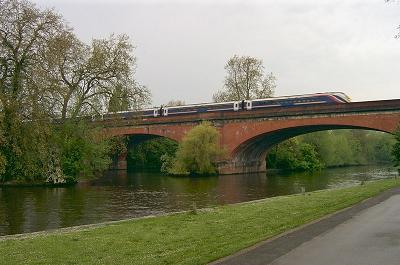Maidenhead Railway Bridge
 Maidenhead Railway Bridge
Maidenhead Railway Bridge
Maidenhead Road Bridge is a fine example of eighteenth century design and workmanship. A series of thirteen arches support the busy A4 roadway which in turn is protected at the sides by a decorative balustrade. Fine example though it is, as a feat of engineering it is dwarfed by the next bridge, the Maidenhead Railway Bridge.
Maidenhead Railway Bridge (or Maidenhead Viaduct) was designed by the great Isambard Kingdon Brunel, and is considered to be the best of the three bridges that he constructed over the Thames. (The other two I have already passed being situated back upstream at Gatehampton and Moulsford).
The construction is all brick, and provides a colourful photograph standing out in deep red against the background grey skies. Just two great arches support the tracks, and at the time it was built these were the widest bridge arches in the world at 128 feet (39m) each. These were also the flattest arches with a rise of only 24 feet (7m). This was essential if Brunel was to retain his obsession with keeping to long and gentle gradients on his railway. So successful was he at achieving this target that the gradient on this whole stretch around Maidenhead has a slope of only 1 in 1,320 a remarkable piece of civil engineering.
Not everyone was confident that Brunel’s engineering would prove to be as effective as he claimed. The board of the Great Western Railway had a touch of the “health and safety” panic and ordered that the wooden framework used to support the arches during construction should remain in place as additional insurance against the bridge collapsing under the weight of the trains. Good old Isambard was having none of it, and arranged for the supports to be slightly lowered so that everything still looked hunky-dory to the men with the clipboards but in fact the support was non-existent. Some years later those wooden supports (or more correctly non-supports) were washed away in floods and the men in suits were astonished when the bridge did not fall down. Brunel was able to say “Told you so” and the framework was never replaced. One can imagine that Brunel is up there somewhere, perched on a cloud with his harp, looking down and saying to the former railway board members, “180 years and still going strong; stick that in your waistcoat pocket”.
The bridge was famously painted by J.M.W.Turner (1775-1851) in his 1844 painting “Rain, Steam and Speed – The Great Western Railway” that can be viewed in the National Gallery, London.
According to the guidebook the arch under which the Thames Pathway passes is known as the “Sounding Arch” because it has a spectacular echo. So as I walk underneath I give a shout (it has to be done) to see if it is true. It is.
Next Page >